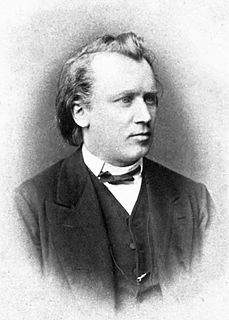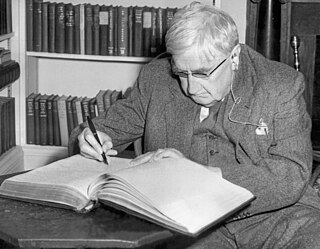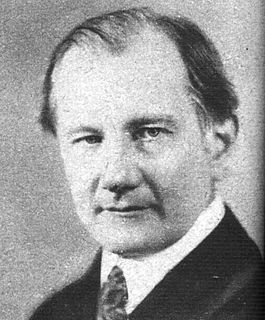Related Research Articles
Robert Wilfred Levick Simpson was an English composer and long-serving BBC producer and broadcaster.

The Symphony No. 94 in G major is the second of the twelve London symphonies written by Joseph Haydn. It is popularly known as the Surprise Symphony.

The Symphony No. 6 in B minor, Op. 74, also known as the Pathétique Symphony, is Pyotr Ilyich Tchaikovsky's final completed symphony, written between February and the end of August 1893. The composer entitled the work "The Passionate Symphony", employing a Russian word, Патетическая (Pateticheskaya), meaning "passionate" or "emotional", which was then (mis-)translated into French as pathétique, meaning "solemn" or "emotive".
The Cello Concerto No. 1 in E-flat major, Op. 107, was composed in 1959 by Dmitri Shostakovich. Shostakovich wrote the work for his friend Mstislav Rostropovich, who committed it to memory in four days and gave the premiere on October 4, 1959, with Yevgeny Mravinsky conducting the Leningrad Philharmonic Orchestra in the Large Hall of the Leningrad Conservatory. The first recording was made in two days following the premiere by Rostropovich and the Moscow Philharmonic, under the baton of Aleksandr Gauk.
The Symphony No. 3 in F major, Op. 90, is a symphony by Johannes Brahms. The work was written in the summer of 1883 at Wiesbaden, nearly six years after he completed his Symphony No. 2. In the interim Brahms had written some of his greatest works, including the Violin Concerto, two overtures, and Piano Concerto No. 2.

Symphony No. 2 in D major, Op. 73, was composed by Johannes Brahms in the summer of 1877, during a visit to Pörtschach am Wörthersee, a town in the Austrian province of Carinthia. Its composition was brief in comparison with the 21 years it took Brahms to complete his First Symphony.

Anton Bruckner’s Symphony No. 2 in C minor, sometimes known as the "Symphony of Pauses", was completed in 1872. It was actually the fourth symphony composed by Bruckner, after the Symphony in F minor (1863), the Symphony No. 1 in C minor (1866), and the Symphony in D minor (1869).

Anton Bruckner's Symphony No. 3 in D minor, WAB 103, was dedicated to Richard Wagner and is sometimes known as his "Wagner Symphony". It was written in 1873, revised in 1877 and again in 1889.
Symphony No. 4, Op. 29, FS 76, also known as "The Inextinguishable", was completed by Danish composer Carl Nielsen in 1916. Composed against the backdrop of the First World War, this symphony is among the most dramatic that Nielsen wrote, featuring a "battle" between two sets of timpani.
A Symphony to Dante's Divine Comedy, S.109, or simply the "Dante Symphony", is a choral symphony composed by Franz Liszt. Written in the high romantic style, it is based on Dante Alighieri's journey through Hell and Purgatory, as depicted in The Divine Comedy. It was premiered in Dresden in November 1857, with Liszt conducting himself, and was unofficially dedicated to the composer's friend and future son-in-law Richard Wagner. The entire symphony takes approximately 50 minutes to perform.

Ralph Vaughan Williams's Symphony No. 8 in D minor was composed between 1953 and 1955. Sir John Barbirolli, its dedicatee, conducted the Hallé Orchestra in the premiere at the Free Trade Hall in Manchester on 2 May 1956. It is the shortest of the composer's nine symphonies, and is mostly buoyant and optimistic in tone.
The Symphony No. 1 in B♭ minor is one of two symphonies by the English composer William Walton. The composer had difficulty in completing the work, and its first public performance was given without the finale, in 1934. The complete four-movement work was premiered the following year.
The Symphony No. 5 by Robert Simpson was written in 1972 and "dedicated in admiration" to the London Symphony Orchestra, who gave the premiere on May 3, 1973, conducted by Andrew Davis. The second performance in England didn't take place until 1984.
Robert Simpson composed his Seventh Symphony in 1977, the same year he completed his Sixth Symphony. The work is dedicated to Hans Keller and his wife, Milein Keller, and was first performed by the Royal Liverpool Philharmonic Orchestra, conducted by Brian Wright at the Philharmonic Hall, Liverpool on 30 October 1984. It is a one-movement work of approximately 28 minutes duration, and since its first performance it has become one of Simpson’s most frequently heard symphonies.
The Symphony No. 9 by Robert Simpson was composed between 1985 and 1987 and commissioned by the Bournemouth Symphony Orchestra who gave the premiere under Vernon Handley at the Poole Arts Centre on 8 April 1987. The work was dedicated to his second wife, Angela. It has been called ‘the largest piece of music written in one tempo’ and, more than any other Simpson symphony, met with immediate critical acclaim. Some music critics and admirers of Simpson’s music consider this symphony to be his finest.
The String Quartet No. 9 by Robert Simpson was written in response to a commission by the Delme Quartet in 1982 to mark their 20th anniversary, one which coincided with the 250th anniversary of the birth of Joseph Haydn. Simpson was among five British composers to write works to mark this dual occasion, producing a very large set of variations on a Haydn theme, a work of some fifty-seven minutes in duration. Its first performance was given in the Wigmore Hall in London on 6 October 1982.
The Flute Concerto by Robert Simpson was composed in 1989 and dedicated to Susan Milan, the flautist who commissioned the work and gave its premiere in May 1992 at the Malvern Festival with the City of London Sinfonia conducted by Richard Hickox.
The Concerto Fantasy for Two Timpanists and Orchestra is a double timpani concerto written by Philip Glass in 2000. It is paired with the Cello Concerto on Vol. I of Glass' Concerto Project, a set of eight concerti by the composer. A typical performance of the work lasts 25–28 minutes. It was written for Jonathan Haas and later recorded by Evelyn Glennie, and was premiered by Haas and Svet Stoyanov with the American Symphony Orchestra in Avery Fisher Hall, Lincoln Center, conducted by Leon Botstein. The work was commissioned jointly by the American Symphony Orchestra, the Peabody Symphony, the Milwaukee Symphony, the St. Louis Symphony and the Phoenix Symphony. In 2004, a transcription for wind ensemble was written by Mark Lortz, which debuted at Peabody Institute in 2005.

The Symphony No. 2 in E, Op. 40, was completed by Ernő Dohnányi in 1944, at the close of the Second World War. It was revised later in the 1950s. Written with audible roots in the Romantic tradition, the work is largely lyrical, yet maintains a controlled militaristic air inspired by the events surrounding its composition. It references a variety of musical backgrounds, including the work of Brahms, Wagner, Kabalevsky, and Bach. Bach's song Komm, süßer Tod serves as the basis for a significant portion of the finale.
Concerto for seven wind instruments, timpani, percussion, and string orchestra is a composition by the Swiss composer Frank Martin.
References
- ↑ Andrew Jacksons, "Recordings and Reviews of Simpson's Works Archived 2008-10-11 at the Wayback Machine . Accessed 5 May 2008
| | This article about a symphony is a stub. You can help Wikipedia by expanding it. |